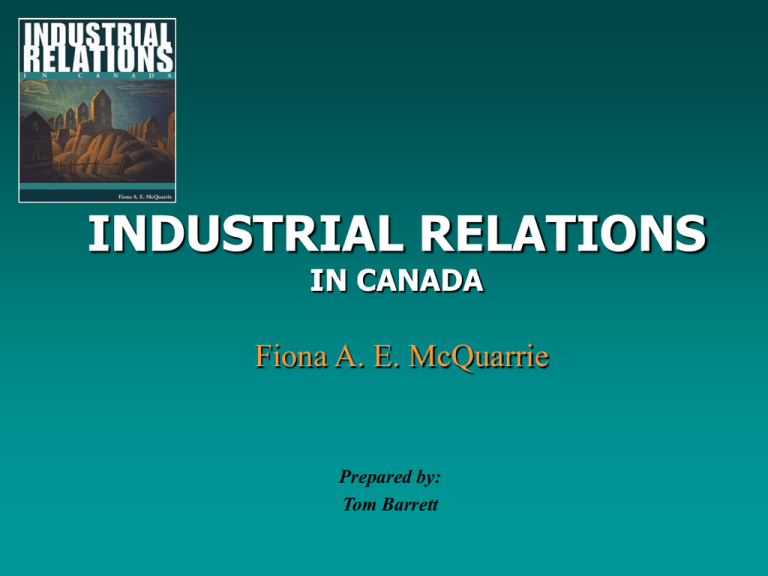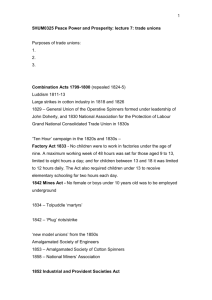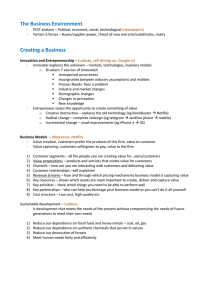
INDUSTRIAL RELATIONS
IN CANADA
Fiona A. E. McQuarrie
Prepared by:
Tom Barrett
Chapter
13
Future Issues for Workers, Work
Arrangements, Organizations, and
the Industrial Relations System
Opening Vignette: Workload a
major issue survey finds
• Workload is emerging as a key collective-bargaining issue
as time-squeezed employees demand their unions do
something to ease the pressure
• A poll by Ottawa-based Ekos Research Associates Inc.
found that 71 percent of unionized workers want
organized labour to give high priority to workload issues
• For the Canadian Union of Public Employees, Canada’s
largest union, workload has emerged as the number one
issue; it is also an issue in private sector bargaining
• At a three-day conference, the Saskatchewan Federation
of Labour discussed strategies for shorter work weeks,
paid family and parental leaves, alternate work
arrangements such as job sharing and flextime, and an
end to overtime
Chapter 13 Objectives
• At the end of this chapter you should be able to:
– Describe the demographic changes occurring in
the Canadian workplace
– Identify some of the union strategies that address
demographic change
– Understand the different forms of work
arrangements
– Explain how unions have responded to new work
arrangements
– Discuss new forms of organizational structures
– Identify factors that may influence Canadian
industrial relations in the future
Changes in Workforce
Demographics
• Since the mid-1960s, both the Canadian workplace
and workforce have changed significantly
• Canadian unions are now facing the necessity of
having to adapt to the new realities of work and must
prove their relevance and value to a new generation
of workers in a variety of workplaces
• Factors such as legislative changes and new
organizing strategies may determine whether
Canadian union membership stays the same, grows,
or declines as is the case in the U.S.
Changes in Workforce
Demographics
• The composition of the Canadian workforce is
changing in many ways:
– There is a wider age range among workers
– More women are entering the workforce
– There is more ethnic and racial diversity in the
workforce
• Each trend poses a different challenge to
unions
Young Workers
• Part-time employment is more prevalent
among this age group than any other
• Some researchers argue this is not a
problem; for many students, part-time
is their only option
• Some believe that we gain a more accurate
picture of youth employment by examining
non-standard work, such as:
– Part-time work, temporary work,
multiple job-holding, and self-employment
• The predominance of non-standard work among
young people may be a concern because of the
insecurity of the employment relationship
work
Young Workers
• Several characteristics of younger
workers’ employment make union
organizing particularly challenging:
– High turnover rate
– They are more vulnerable to
employer retaliation
– Their employers traditionally display
higher resistance to unionization
– Young workers are often unfamiliar with unions or have
an unfavourable perception of unions
– There may also be opposition toward organizing these
industries or sectors from within the union movement
Female Workers
• The number of Canadian women in the workforce
has increased steadily over the past few decades
• The majority of Canadian women who work outside
the home have full-time jobs – but the proportion of
part-time to full-time workers is higher for
women than men
• As the number of women in the
Canadian workforce increases, so has
the number of Canadian women who belong to
unions
• Both percentages – women as a percentage of total
union membership, and female union members as a
percentage of all working women – are comparable
to male workers
Female Workers
• The unions’ ability to represent female members
effectively has also been hampered by the
inability or unwillingness of female workers to
participate in union activities
• Gender imbalance in union participation
may mean issues of concern to
female union members are not
adequately addressed
• Women enter and leave the labour force or change
their employment status more often than men,
making them harder to organize and represent
• More women are engaging in temporary work, parttime work, and self-employment
Older Workers
• A surprising number of older workers continue to
participate in the labour force beyond retirement
age
• The participation rate (percentage of individuals in
a demographic group who hold paid employment
outside the home) among older workers indicates
fewer older female workers than older male
workers
• However, the participation rate among older female
workers—except for the 70-plus age group—has
increased over the past 10 years
• The participation rate among older male workers
decreased during the same period
Older Workers
• Unionization rates for older
workers aged 55 and up are comparable
to the overall average unionization rate
• As a result, Canadian unions
have not felt the need to increase
unionization among older workers
• Older workers may have trouble
demonstrating the benefits of “their” issues to
younger workers
Ethnic and Racial Diversity in the
Workforce
• There is an increase in workers belonging to visible
minority groups
• Occupational patterns for visible minorities are
similar to non-minorities
• Adults who belong to visible minority
groups are more likely to have a university
degree than those who do not
• However, visible minority workers with university
degrees are not as likely to be employed in higherpaying professional or managerial occupations—this
is known as underemployment
Ethnic and Racial Diversity in the
Workforce
• There are many debates over whether employment
equity laws are effective or whether they cause
reverse discrimination
• There are no statistics, but it is not unreasonable to
assume that problems of racial and ethnic inclusion in
unions are similar to those of women
• Members of visible minorities in Canada are more
likely than non-minority workers to be employed in
difficult-to-organize occupations
• Immigrants may come from cultures or countries
where unions are perceived negatively
Union Strategies for Dealing
with the Changing Workforce
• It is generally acknowledged that unions must
change in order to survive and provide effective
representation
• To expand, unions need to recognize the
characteristics of the diverse sectors of the
labour market
• For example, CUPE has attempted to increase the
visibility of First Nations members, ethnic or
racial minority members, and gay, lesbian, and,
bisexual union members
Union Strategies for Dealing
with the Changing Workforce
• Union activities targeting young workers are less
prevalent
• Some researchers suggest that the lack of interest in
unionization among younger workers may not be a
problem
• Unionization likely becomes more important to young
workers as they move into more substantive and
permanent employment
• However, some Canadian unions have taken the
position that young workers can benefit from unions
even if they are in non-permanent positions
Union Strategies for Dealing
with the Changing Workforce
• One study suggests that unions are concentrating
organizing efforts on growing employment sectors
and this shows that unions recognize and are
acknowledging the changes in the labour market
• Internal problems in union administration can
sometimes inhibit organizing activity, however
• The decline in union membership results in reduced
revenues from membership dues and thus, reduced
resources for organizing
Changing Work Arrangements
• Unionism first evolved according to the
“industrial” model – unions were established
and developed in workplaces where workers
attended work regularly and worked shifts
determined by the employer
• Many workplaces have moved away from the
industrial model and are exploring alternative
ways of structuring work; this is a new
challenge for unions
Alternative Forms of Work
Scheduling
• Alternative forms of work scheduling include:
– Flextime – workers are allowed to partially or
completely determine their own work hours
– Compressed workweeks – workers are allowed to
work longer shifts in exchange for more days off
– Job sharing – two employees share one full-time
job
• Unions that are attempting to organize workers
on flexible work schedules face problems – e.g.,
how to contact an employee whose hours or
days of work are continually changing
Telecommuting
• Telecommuting – an employee works
partially or completely at home and
communicates with the workplace
through computers, faxes, and
telephones
• Telecommuting arrangements
contradict one of the most basic assumptions in
labour and employment standards legislation—
employees work at a centralized workplace where
the employer dictates the conditions and content
of work
Different Employment
Relationships
• Non-permanent employment relationships
such as contract, term, or temporary work
are becoming more available
• Some of Canada’s largest unions have
negotiated collective agreements that validate
changing work arrangements, but establish
rules to regulate use
Union Responses to Changing
Work Arrangements
• The B.C. film industry is an example of how
unions actively address issues relating to nontraditional forms of work through collective
agreements
• Unions have negotiated terms that attempt to
balance flexibility in employment and alternative
employment relationships with the protection of
their members’ working conditions
• However, unions are generally reluctant to even
suggest any form of non-traditional work
arrangement
Changes in Organizational
Structures
• Traditionally structured industrial organizations
have several distinctive levels of hierarchy
• Authority and power are greater at higher levels
of the hierarchy, with the most power and
responsibility concentrated at top
Changes in Organizational
Structures
Pyramid Structure
Figure 13-1
Traditional
Organizational
Structure
President
Vice-President
Area Supervisors
Front-line Supervisors
Non-managerial Employees
Changes in Organizational
Structures
Divisional Structure
President
Figure 13-1
Traditional
Organizational
Structure
VP Marketing
VP Production
VP Finance
Marketing
department
Production
department
Finance
department
Changes in Organizational
Structures
• One of the motivations behind the formation
of unions was the dissatisfaction with the
distribution of power and authority in
traditionally structured organizations
• Some factors have revealed limitations in
traditional organizational structures:
– Changes in the structure of markets, such as
globalization
– Changes in the purpose of organizations, such
as broader product or service offerings
Changes in Organizational
Structures
• Organizations are exploring other forms of
structure:
– The flatter organization – decreased levels of
hierarchy
– Matrix and network (or web) organizations –
involving more equitable distributions of power
• New forms of organizational structure are
problematic for unions because they reduce or
eliminate traditional distinctions between
employers or managers and employees
Changes in Organizational
Structures
• Unions may also have to deal with practical
problems associated with structural change,
such as:
– Downsizing – the elimination of jobs or the
reduction of work through such methods as
changing full-time work to part-time work
– Changes in the job content
• Changes associated with globalization may be
a more direct threat to the ability of unions to
represent their members
Union Responses to Changing
Organizational Structures
• A balancing act for unions:
– The organizational structure is sometimes
changed to encourage more cooperative
worker-employer relationships
– Control and direction remains with the
employer, thus unions still have a role to play
in ensuring that workers’ issues are addressed
– However a union’s opposition to needed
change may impair an organization’s chances
for long-term survival
Union Responses to Changing
Organizational Structures
• Examples of union responses to changing
organizational structures:
– The Canadian Auto Workers (CAW), while formally
rejecting the idea of “employee partnership,” or
other forms of employee-employer cooperation,
have undertaken certain cooperative initiatives,
e.g., participating in the General Motors Quality
Council
– The Communications, Energy and Paperworkers
Union at Saskatoon Chemicals agreed to
significant work redesign
Factors Influencing the Future of
Industrial Relations in Canada
• What happens next?
– Some researchers question whether a system
based on an industrial and hierarchical model
of organization can continue to be effective
– Other researchers suggest Canadian unions
will soon encounter the same troubles as
those in the U.S.
– Still other researchers argue that the Canadian
industrial relations system is healthy and will
remain that way
Legislation
• One significant difference between Canadian and
American industrial relations systems is jurisdiction
• There is little consensus on whether decentralization
of Canadian labour legislation will help or hinder
Canadian industrial relations
• Some researchers argue that decentralization is
appropriate in Canada because of the wide variations
in labour markets and in the types of employment
• However, decentralization has also been
characterized as hindering the growth of Canadian
unions because of the need to accommodate the
variations in legislation across jurisdictions
Legislation
• A more significant factor is the content of the
laws themselves
• In the past decade, two provincial governments
have altered labour legislation in ways that
suggest they believe the system does not foster
healthy, competitive enterprise
• The Conservative government in Ontario altered
the Labour Relations Act in several significant
ways during the 1990s
• One of the results of those changes was that
certification became more difficult
Legislation
• In May, 2002, the Liberal government in B.C.
made several revisions to the Labour Relations
Code:
– The option of automatic certification was removed
– The B.C. Labour Relations Board was given eight
specific duties to consider when interpreting and
applying the Code
– The language governing communication during an
organizing campaign was broadened
• These changes are considerably more extensive
than any recent changes in other jurisdictions
Political Influence
• The decline of the NDP has led some
observers to question whether labour’s
affiliation with this party is a threat to
the future of the labour movement
• In order to have a meaningful voice in
shaping public policy, the Canadian labour
movement needs to be aligned with a political
party that has sufficient representation or
support
• It appears the NDP is no longer able or willing to
fulfill this role
Political Influence
• Unless the labour movement and the NDP are
able to rebuild their formerly productive
relationship, the labour movement must seek
other allies through which to build political
influence
• American unions have responded to their lack of
political influence in several innovative ways
– The American Federation of Labor-Council of
Industrial Organizations (AFL-CIO) has explicitly
changed strategic focus to include international
issues such as global protectionism and
international monetary policy
Political Influence
• Many Canadian unions and labour federations have
adopted policies similar to AFL-CIO policies
• The Canadian union movement has taken steps to
form alliances with other social activist groups
• It is debatable whether these types of alliances will
create the degree of influence necessary to
significantly affect government policy
• The Canadian labour movement may have to choose
between attempting to rebuild the NDP and actively
supporting labour-friendly candidates who may not
represent NDP
Union Organizing
• Canadian union density has not decreased, but
neither has it shown any significant increase
• Opinions are mixed on whether Canadian unions will
be able to pursue a strategy of growth given the
stagnation of the past two decades
• The negative argument:
– Unions have achieved only modest increases in density
rates over the past 20 years for part-time workers and
have made almost no improvement in major parts of
the private sector
• The positive argument:
– The major differences between U.S. and Canadian
labour law may at least ensure that Canadian union
membership remains steady
Union Organizing
• Membership may grow as Canadian unions adapt to
changing workplace realities
• An example of this is demonstrated by unions in the
entertainment industry in the U.S.
• These unions do not focus on bargaining individual
agreements for each workplace or project, but aim to
achieve standard or national agreements with major
employers
• The have bargained not only for wages, but for
mechanisms that protect members’ employment
prospects and skill development
• They place a high priority on providing services to
their members
Union Organizing
• Canadian unions facing organizational
difficulties can survive and even expand in an
unfavourable environment if they:
– Consider long-term goals when bargaining
– Do not focus solely on wage issues
– Actively adapt to changes in workplace
conditions in ways that benefit the
membership
– Serve the specific needs of the membership
Union Organizing
• A recent Supreme Court of Canada decision has
raised the possibility that unions may be able to
organize workers previously excluded from
unionization
• Dunmore v. Ontario (Attorney General) reversed the
Ontario government decision to exclude farmworkers
from the coverage of the Ontario Labour Code
• This decision may set a precedent and permit unions
to organize farm workers and other groups normally
excluded from the coverage of the labour code
• These groups may include professionals, domestic
workers, and some types of public servants
Copyright
Copyright © 2002 John Wiley & Sons Canada, Ltd. All rights reserved.
Reproduction or translation of this work beyond that permitted by
CANCOPY (Canadian Reprography Collective) is unlawful. Request for
further information should be addressed to the Permissions Department,
John Wiley & Sons Canada, Ltd. The purchaser may make back-up copies for
his / her own use only and not for distribution or resale. The author and the
publisher assume no responsibility for errors, omissions, or damages, caused
by the use of these programs or from the use of the information contained
herein.







